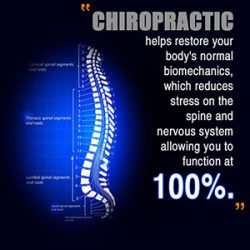 Chiropractic Care and Correction of a Bad Posture.
Chiropractic Care and Correction of a Bad Posture.
Having good posture has always been considered important and chiropractic care plays an important role by keeping your spine aligned.
So, what is good posture and why should we bother with our posture?Posture means ‘the position you hold your body during certain activities, not just standing and sitting’.
It relates to all activities.Good posture helps your body function better. If you have correct posture for the activity you are doing, your body will need less effort doing it and be less likely to get injured. Good posture will give you better mechanical advantage and reduce strain on certain parts of your body that are prone to injury.This is particularly important in physical activities, such as manual labor, gardening and sports, and that applies to athletes of all abilities.If you make better use of the natural lever systems in the body you will get better mechanical advantage, which will get the job done with less effort and with less risk of injury.
Posture of the Spine and the Nervous System
Common interferences to the nervous system occur between some of the 24 moving bones of the spinal column. A loss of normal motion or position of these bones can irritate or impair the function of the nervous system.
This can disrupt the transmission of controlling nerve impulses. With improved spinal function people often report improved organ and system function. Your Chiropractor can help remove any interference that may be impairing normal health.
When under proper control of your nervous system, all the cells, tissue, and organs of your body are designed to resist disease and ill health. The Chiropractic approach to better health is to locate and help reduce interferences to your natural state of being healthy.
Causes of poor posture
The causes of faulty posture can be divided into two categories: positional and structural.
Structural causes are basically permanent anatomical deformities that may not amenable to correction by conservative treatments. However, some leg length inequalities and some ankle and foot issues can be corrected conservatively.
Positional causes of poor posture include
- poor postural habit—for whatever reason, the individual does not maintain a correct posture
- psychological factors, especially self-esteem
- normal developmental and degenerative processes
- pain leading to muscle guarding and avoidance postures
- muscle imbalance, spasm, or contracture
- joint hypermobility or hypomobility
- respiratory conditions
- general weakness
- excess weight
- loss of proprioception—the ability to perceive the position of your body
- over reliance on passive support from a non-ergonomic chair
Physiology of posture
Posture control involves static and phasic reflex activities:
- Static reflexes involve sustained contraction of the musculature.
- Dynamic short-term phasic reflexes involve transient movements.
Both types of reflex are integrated at various levels in the central nervous system (CNS) from the spinal cord to the cerebral cortex and are largely effected through extrapyramidal motor pathways.
Postural reflex patterns from reflexes, such as the stretch and flexion (withdrawal) reflex pathways, result in a coordination of many joint movements and combinations of muscle actions:
- These involve the contraction of prime movers, synergists, and stabilizers, along with the necessary relaxation of antagonists.
- These muscles are regulated for contraction intensity, speed, duration, and sequential changes in activity.
The integrative pattern of posture is predominantly automatic and unconscious, resulting from the incessant shifting of weight (postural sway).
Postural corrections are continuously mediated by spinal reflexes. Posture is further mediated by the visual, labyrinthine, neck-righting reflexes, and by the interplay of joint reflexes.
While the control of posture is primarily controlled by various reflex mechanisms, there is also extensive input from the higher centers of the nervous system. Therefore, posture to some extent can be relearned (corrected) just as it was learned in the first place.
Correcting postural faults
Postural faults must be accurately analyzed before they can be effectively corrected.
Examination should include the following:
- observation of the patient as they sit and move about
- spinal alignment
- if appropriate: measurement or estimation of the deviation from ideally erect postures using plumb lines, inclinometry, and posture guides —done in three or all four views
- limb length and girth measurements
- flexibility tests and joint mobility tests
- muscle length and strength tests
The importance of muscle testing to postural analysis cannot be over-emphasized. Much of the specific therapy in posture correction relies directly on muscle tightness and weakness found during examination.
A photo posted by Eduard Burt, D.C., MUAC (@burtchiropractic) on
Conventional corrective therapies
Six main modalities are employed in the conventional treatment of faulty body mechanics and hence postural faults: chiropractic; heat; massage; stretching; strengthening exercises; and supportive measures to treat ligaments, bones, and nerves.
These days, more and more people find themselves sitting in front of computer screens or television sets for long periods of time. Only a small percentage of people exhibit good posture when they are sitting. That’s because it is
hard to sit up straight for eight hours at a time. Eventually, you will find yourself slouching or leaning forward to get a better look at the computer screen. Over time, the bad posture can really start to add up and take a physical toll on your body. You may start to feel tight or stiff in your shoulders and neck, or you could experience lower back pain.
If you have ever felt like there’s a knot of muscle tension in your neck or back, it may be a sign that you are exhibiting poor posture. This tension will only get worse over time, and can begin to seriously impact your quality of life. With quality chiropractic care, you can fix the problem before it gets out of hand.
A photo posted by Eduard Burt, D.C., MUAC (@burtchiropractic) on
